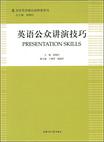英语公众讲演技巧
2009-3
上海交通大学出版社
赵晓红,丁雅萍,杨晓玲 著
234
21世纪要求学校培养的人才既要有知识又要有能力,高校毕业生不仅要具有扎实的基础知识,而且还要有宽广的知识面,文理结合,全面发展。这一要求对高校的外语教学也提出了新的任务。高校外语教学不只着重语言知识的传授,还要帮助培养学生的各种英语能力,为适应现代社会做积极的准备。新颁布的《大学英语课程教学要求》和新修订的《非英语专业硕士/博士学位研究生英语教学基本要求(试行)》也明确地反映了这一点。《大学英语课程教学要求》指出:大学英语课程不仅是一门语言基础课程,也是拓宽知识、了解世界文化的素质教育课程,兼有工具性和人文性。因此,设计大学英语课程时也应当充分考虑对学生的文化素质培养和国际文化知识的传授。《非英语专业硕士/博士学位研究生英语教学基本要求(试行)》也指出:各个院校和科研机构可以根据需要和可能,为学生开设实用性强的各类英语选修课程,如以语言、文学、哲学、文化、外国概况等为内容的素质课,以社会交往、国际礼仪等为内容的社交课,以英语国家生存常识为内容的出国预备课等。博士研究生英语的教学目的以培养学生用英语进行工作和研究的能力为重点,通过英语教学有效地培养学生用英语进行工作沟通和学术交流的能力。 在大纲的指导下,近年来,许多综合性重点高校都在积极进行英语课程结构的改革。除传统的基础英语课程外,许多高校都开设了各种门类的英语选修课,以帮助提高毕业生的英语综合应用能力,增强自主学习能力,培养综合文化素养,适应我国社会发展和国际交流的需要。 高校英语选修课门类现在虽然很多,但归纳起来,主要有三类,即“语言实际知识与技能类”、“语言应用类”和“语言与文化类”。“语言实际知识与技能类”主要涉及阅读、口语、写作、听力、翻译技能的进一步培养,如中高级口译、翻译理论与实践、演讲与辩论等;“语言应用类”包括商务英语、传媒英语、科技英语、英语学术论文写作、应用文写作等;“语言与文化类”涉及英美社会与文化、西方文学选读、影视欣赏、英美报刊选读等。针对这些选修课,有些高校也编写了相应的教材,但总体上,教材的门类不全,有些课程老师就是选不到一本对教、学双方都适用的教材,有的甚至找不到任何教材,造成某些课程都是老师自编讲义,或每个地方凑一点拿来作为课堂教学使用,因而在教学内容的系统性、延续性和规范性方面都存在较大的随意性,也不方便学生自主学习。加上中国老师和学生都不太适应零散的教学资料,所以有些选修课感觉就是结构松散、不太正规。
《英语公众讲学技巧》对英语讲演的开始阶段、准备过程,到具体讲演技巧逐一做了介绍,以便读者掌握有关讲演的技巧:如何吸引听众、如何展开论点、如何导出结论等;并介绍了讲演语言的特殊性。《英语公众讲学技巧》可作为高校英语选修课教材,书中配备了相应的练习,供读者按自身情况选择使用。
Part Ⅰ Introduction1 Overview of Presentation Skills1.1 Definition of Presentation Skills1.2 Importance of Presentation Skills1.3 Essential Qualities of a Good Public Speaker1.4 Types of Presentations1.5 Overall Structure of a PresentationPart Ⅱ Speech Preparation: Getting Started2 Initial Considerations2.1 Analyzing the Audience2.2 Selecting a Topic2.3 Selecting a Purpose2.4 Composing a Thesis Statement3 Gathering Supporting Materials3.1 Sources of Materials3.2 Types of Supporting Materials3.3 Tips for Selecting Materials3.4 Avoiding PlagiarismPart Ⅲ Speech Preparation: Outlining and Organizing4 Outlining4.1 Preparation Outlines4.2 Speaking Outlines4.3 Sentence, Phrase, and Key-word Outlines5 Developing an Attention-getting Introduction5.1 Major Types ot7 Attention Getters5.2 Establishing Credibility5.3 Providing a Purpose5.4 Stating Your Thesis5.5 Previewing Main Points5.6 Putting the Introduction Together6 Organizing the Body of the Presentation6.1 Guidelines for Determining Main Points6.2 Organizing the Main Points6.3 Organizing Supporting Materials7 Developing the Conclusion7.1 Signaling Your Conclusion7.2 Repeating the Topic, Purpose and Thesis7.3 Reviewing the Main Points7.4 Closing Your Presentation7.5 Transitioning to Questions7.6 Putting the Conclusion Together8 Connectives8.1 Transitions8.2 Internal Previews8.3 Internal Summaries8.4 SignpostsPart Ⅳ Presenting the Speech9 Presenting with Effective Language9.1 Style of the Presentation Language9.2 Tips for Using Language Effectively10 Using Visual Aids Effectively10.1 Advantages of Visual Aids10.2 Types of Visual Aids10.3 Tips for Designing PowerPoint Slides10.4 Tips for Using PowerPoint Slides11 Delivering a Speech Effectively11.1 Qualities of Effective Delivery11.2 Methods of Delivery11.3 Vocal Elements in Delivery——Making Effective Use of Your Voice11.4 Physical Elements in Delivery——Making Effective Use of Your Body11.5 Practicing Delivery11.6 Overcoming Speech Anxiety12 Handling Audiences Questions Effectively12.1 Tips for Handling Questions Effectively12.2 Summary of the ChapterPart Ⅴ Major Types of Presentations13 InformativePresentations13.1 Types of Informative Presentations13.2 Tips for Informative Presentations13.3 Sample Informative Speech with Commentary14 Persuasive Presentations14.1 Types of Persuasive Presentations14.2 Organizational Patterns for Persuasive Presentations14.3 Methods of Persuasion14.4 Sample Persuasive Speech with Commentary15 Presentations on Special Occasions15.1 Speeches of Introduction15.2 Speeches of Presentation15.3 Speeches of Acceptance15.4 Commemorative Speeches15.5 After-dinner SpeechesAnswers to ExercisesAppendix Ⅰ Sample Complete Presentations and Famous SpeechesAppendix Ⅱ Famous Sayings and QuotationsAppendix Ⅲ A List of Mispronounced Words by Chinese StudentsAppendix Ⅳ Detailed ContentsAppendix Ⅴ Bibliography
Reading from Manuscript As the name suggests, reading from manuscript means reading from fullyprepared written text, word by word. This method is often used in situationswhere absolute accuracy is essential. Politicians and business leaders find thismethod more helpful because it can help them avoid being misquoted or misinterpreted.They want to communicate exact information. However, it can be boring to listen to a speaker who reads word by wordfrom a manuscript. Reading restricts eye contact and body movement, and maylimit expressiveness in vocal variety, too. Consequently, the quality and effectivenessof the speech delivery can also be limited. To overcome the disadvantages and increase your expressiveness, you shouldpractice reading the manuscript often and become familiar with it before the delivery.Reciting from Memory By this method, the speech is delivered entirely from memory. Since itsneither customary nor necessary to memorize an entire speech in real life, thismethod is rarely used except for some special or brief speeches such as speechcontests, short toasts, congratulatory remarks, introductions, etc. Besides,reciting from memory can be boring if the speaker keeps gazing at the ceiling,trying to recall what he/she has memorized, rather than concentrates oncommunicating with the audience and conveying enthusiasm and directness.
高校外语教学不只着重语言知识的传授,还要帮助培养学生的各种英语能力,为适应现代社会作积极的准备。 开设实用性强的各类英语选修课程,如以语言、文学、哲学、文化、外国概况等为内容的素质课,以社会交际、国际礼仪等为内容的社交课,以英语国家生存常识为内容的出国预备课等,通过英语教学有效地培养学生用英语进行工作沟通和学术交流的能力。
